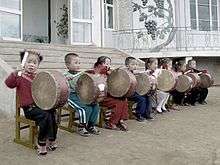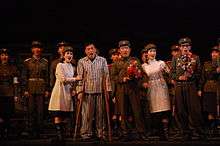Music of North Korea

Music of North Korea is heavily influenced by the political situation in the country. Many songs are related to the North Korean cult of personality.
Taejung kayo
After the division of Korea in 1945 and the establishment of North Korea in 1948, revolutionary song-writing traditions were channeled into support for the state, eventually becoming a style of patriotic song called taejung kayo in the 1980s[1] combining classical Western symphonic music and Korean traditional musical forms.[2] The songs are generally sung by female performers with accompanying bands or choirs accompanied by a large orchestra (either Western style or a hybrid of western and traditional) or concert band.
North Korean music follows the principles of Juche (self-reliance) ideology. The characteristic march like, upbeat music of North Korea is carefully composed, rarely individually performed, and its lyrics and imagery have a clear optimistic content.
Much music is composed for movies, and the works of the Korean composer Isang Yun (1917-1995), who spent much of his life in Germany, are popular in North Korea.
Pop music

Under Kim Il-sung's era, only ideologically correct music was allowed. Jazz in particular was considered out of bounds. Many artists however found their way around these limitations by writing ideologically correct lyrics while taking liberties with the score. Under Kim Jong-il, previously forbidden genres, even jazz, became permissible and encouraged.[3]
Many North Korean pop songs are usually performed by a young female singer with an electric ensemble, percussionist, and accompanying singers and dancers. Some North Korean pop songs such as "Hwiparam" ("Whistle")—set to the lyrics of North Korean poet Cho Ki-chon[4]—have become popular in South Korea.[5] They are primarily influenced by Korean pop music and songs have titles like "Don't Ask My Name", "Our Life Is Precisely a Song", "We Shall Hold Bayonets More Firmly", "The Joy of Bumper Harvest Overflows Amidst the Song of Mechanisation",[6] "The Dear General Uses Distance-Shrinking Magic (Chukjibeop)",[7] "Song of Bean Paste", "My Country Full of Happiness", "Pleasant Snack Time", "I Also Raise Chickens", "The Shoes My Brother Bought Fit Me Tight",[8] "Potato Pride"[9] and many more.
Songs like "We Are One" and "Reunification Rainbow" sing of the hopes for Korean reunification. In 2012, North Korea's first girl band, the Moranbong Band, made its world debut.[10] It is a group of about sixteen North Korean women (eleven instrumentalists and five singers) which was hand-selected by Kim Jong-un.[11]
BBC radio disc jockey Andy Kershaw noted, on a visit to North Korea, that the only recordings available were by the pop singers Jon Hye-yong, Kim Kwang-suk, Jo Kum-hwa and Ri Pun-hui, and the groups Wangjaesan Light Music Band, the Mansudae Art Troupe and the Pochonbo Electronic Ensemble, who play in a style Kershaw refers to as "light instrumental with popular vocal".[6] There is also the State Symphony Orchestra, the Sea of Blood Opera Company, two choruses, an orchestra and an ensemble dedicated to Isang Yun's compositions, all in Pyongyang. The Pyongyang Film Studios also produces many instrumental songs for its films, and several programs on Korean Central Television have music made and performed by the Central Radio and Television Orchestra.
North Korean pop music is available for visitors to Pyongyang at the Koryo Hotel or Number One Department Store.[8]
Folk music
Some religious or original folk music may still exist in North Korea, but reliable sources are absent in the West.
Instruments
Like Korean music in general, North Korean music includes kinds of both folk and classical, courtly music, including genres like sanjo, pansori, and nongak. Pansori is long vocal and percussive music played by one singer and one drummer. The lyrics tell one of five different stories, but is individualized by each performer, often with updated jokes and audience participation. Nongak is a rural form of percussion music, typically played by twenty to thirty performers. Sanjo is entirely instrumental that shifts rhythms and melodic modes during the song. Instruments include the changgo drum set against a melodic instrument, such as the gayageum or ajaeng.[6]
In North Korea, traditional instruments have been adapted in order to allow them to compete with Western instruments. Many older musical forms remain and are used in both traditional performances that have been attuned to the ideas and the way of life of the modern North Korean communist state and to accompany modern songs in praise of Kim Il-sung, his son and successor, Kim Jong-il, and Kim Jong-un from 2012 onward, plus songs that wish for a reunited Korea, thus creating a mix of traditional and Western music that is truly North Korean, a unique variant of Korean music as a whole mixing the old and the new.
The modern Ongnyugeum zithers and the Sohaegeum four stringed fiddle are North Korean modernized versions of traditional Korean musical instruments, both used in traditional and modern musical forms.
Military music, in contrast, often makes extensive use of Western brass, woodwind, and percussion instruments, often omitting the Korean ones entirely. Although usually original compositions, the melodies are not easily distinguishable from Western ones in the absence of their lyrics, which heavily feature the customary ideologically oriented content.
Active musical groups and ensembles
Military
- Song and Dance Ensemble of the Korean People's Army
- Korean People's Army State Merited Chorus and Symphony Orchestra
- Song and Dance Ensemble of the Korean People's Navy
- Song and Dance Ensemble of the Korean People's Air Force
- Song and Dance Ensemble of the Department of People's Security of the DPRK
- Central Military Band of the Korean People's Army
- Women's Military Marching Band of the Department of People's Security of the DPRK
Civilian
- Unhasu National Orchestra
- State Symphony Orchestra of the Democratic People's Republic of Korea
- Isang Yun Symphony Orchestra
- Pochonbo Electronic Ensemble
- Wangjaesan Light Music Band and Wangjaesan Dance Troupe
- Moranbong Band
- Chongbong Band[12]
- Musical groups under the Mansudae Art Troupe (MAT)
- MAT Merited Women's Instrumental Ensmeble[13]
- MAT Chorus
- Pyongyang Philharmonic Orchestra
- National Philharmonic Orchestra of the Democratic People's Republic of Koreas
- National Folk Art Troupe[15]
- Pyongyang Symphony Orchestra
- Phibada Opera Troupe[16]
- State Youth Orchestra of the Democratic People's Republic of Korea
- Kim Il-sung Youth Philharmonic
- KCBS-KCTV Central Radio and Television Orchestra
See also
References
- ↑ "Pop music of Asia". IIAS Newsletter Online. Retrieved September 27, 2005.
- ↑ World and Its Peoples: Eastern and Southern Asia. Marshall Cavendish Corporation. 2007. p. 929. ISBN 9780761476313.
- ↑ Tertitskiy, Fyodor (6 June 2016). "The good things in North Korea". NK News. Retrieved 20 July 2016.
- ↑ Gabroussenko, Tatiana (2005). "Cho Ki-ch'ŏn: The Person Behind the Myths". Korean Studies. 29: 79. doi:10.1353/ks.2006.0005.
- ↑ Chun Su-jin (6 October 2002). "Attention! Military more receptive to filmmakers". Korea Joongang Daily.
- 1 2 3 Provine, Rob, Hwang, Okon and Kershaw, Andy. "Our Life Is Precisely a Song". 2000. In Broughton, Simon and Ellingham, Mark with McConnachie, James and Duane, Orla (Ed.), World Music, Vol. 2: Latin & North America, Caribbean, India, Asia and Pacific, pp 160-169. Rough Guides Ltd, Penguin Books. ISBN 1-85828-636-0
- ↑ Wangjaesan Light Music Band, "The General Uses Warp. Korean Central Television
- 1 2 Broughton, Simon; Ellingham, Mark; McConnachie, James; Duane, Orla (2000). World Music: Latin and North America, Caribbean, India, Asia and Pacific, Volume 2 (New ed.). London: Rough Guides. p. 167. ISBN 9781858286365. Retrieved 31 July 2015.
- ↑ "Oh Potatoes!". allaroundthisworld.com. Retrieved 4 August 2015.
"Potato Pride" is a North Korean propaganda tune in which the elder of the village receives his government ration of potatoes and shares it with his fellow villagers.
- ↑ Patrick Boehler (6 July 2013). "Moranbong style: North Korea's first girl band may be a sign of change". South China Morning Post.
- ↑ Beth Stebner (29 May 2013). "North Korea's five-part girl band, formed by Supreme Leader Kim Jong Un, blast out hits like 'Let's Study!' and 'Our Dear Leader!'". New York Daily News. Retrieved 31 July 2015.
- ↑ "N. Korea's all-female band unveiled in Moscow". Yonhap. 2 September 2015. Retrieved 9 September 2015.
- 1 2 "Samjiyon Band". Naenara. Foreign Languages Publishing House. 16 January 2013. Retrieved 3 February 2018.
- ↑ Ha Yoon Ah (18 January 2018). "Why is North Korea sending the Samjiyon Orchestra to the Olympics?". Daily NK. Retrieved 3 February 2018.
- ↑ Zhang Jingya, ed. (2013-01-27). "DPRK national folk art shines in South China". english.cntv.cn. Retrieved 2015-05-23.
- ↑ Stage Art of DPRK Improved in 2012 Archived 2013-01-21 at the Wayback Machine.
External links
- BBC Radio 3 Audio (75 minutes): Kershaw in North Korea, part 1. Accessed November 25, 2010.
- BBC Radio 3 Audio (90 minutes): Kershaw in North Korea, part 2. Accessed November 25, 2010.
- Kim Jong-il Janggunui Norae - example of North Korean Music, with lyrics (in Korean) and mp3 recordings: (External; licensed for non-commercial use.)
- Music of Korea - mp3 recordings at Naenara
- Concert of the Korean People's Army Military Band on YouTube
- Music of North Korea at Curlie (based on DMOZ)